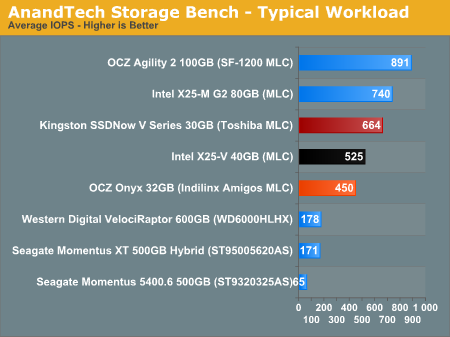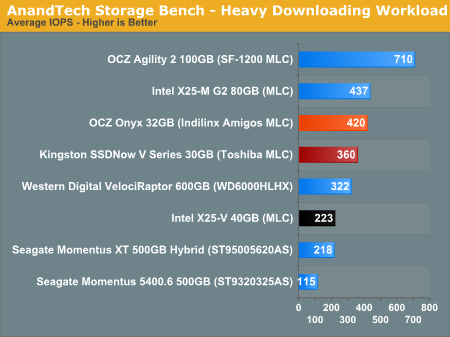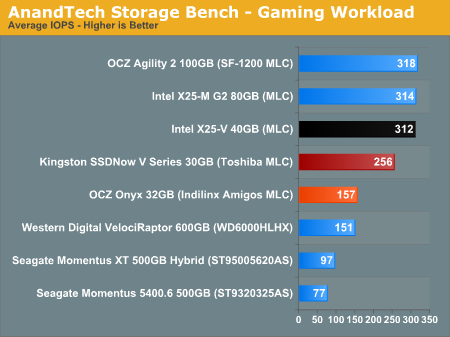2010 Value SSD (~$100) Roundup: Kingston and OCZ take on Intel
by Anand Lal Shimpi on June 3, 2010 12:01 AM ESTAnandTech Storage Bench
The first in our benchmark suite is a light usage case. The Windows 7 system is loaded with Firefox, Office 2007 and Adobe Reader among other applications. With Firefox we browse web pages like Facebook, AnandTech, Digg and other sites. Outlook is also running and we use it to check emails, create and send a message with a PDF attachment. Adobe Reader is used to view some PDFs. Excel 2007 is used to create a spreadsheet, graphs and save the document. The same goes for Word 2007. We open and step through a presentation in PowerPoint 2007 received as an email attachment before saving it to the desktop. Finally we watch a bit of a Firefly episode in Windows Media Player 11.
There’s some level of multitasking going on here but it’s not unreasonable by any means. Generally the application tasks proceed linearly, with the exception of things like web browsing which may happen in between one of the other tasks.
The recording is played back on all of our drives here today. Remember that we’re isolating disk performance, all we’re doing is playing back every single disk access that happened in that ~5 minute period of usage. The light workload is composed of 37,501 reads and 20,268 writes. Over 30% of the IOs are 4KB, 11% are 16KB, 22% are 32KB and approximately 13% are 64KB in size. Less than 30% of the operations are absolutely sequential in nature. Average queue depth is 6.09 IOs.
The performance results are reported in average I/O Operations per Second (IOPS):

Our storage suite puts more emphasis on sequential transfers than PCMark Vantage and thus Kingston gets the performance advantage here in our typical/light workload case. It's a very realistic workload and one that gives Kingston the overall advantage.
If there’s a light usage case there’s bound to be a heavy one. In this test we have Microsoft Security Essentials running in the background with real time virus scanning enabled. We also perform a quick scan in the middle of the test. Firefox, Outlook, Excel, Word and Powerpoint are all used the same as they were in the light test. We add Photoshop CS4 to the mix, opening a bunch of 12MP images, editing them, then saving them as highly compressed JPGs for web publishing. Windows 7’s picture viewer is used to view a bunch of pictures on the hard drive. We use 7-zip to create and extract .7z archives. Downloading is also prominently featured in our heavy test; we download large files from the Internet during portions of the benchmark, as well as use uTorrent to grab a couple of torrents. Some of the applications in use are installed during the benchmark, Windows updates are also installed. Towards the end of the test we launch World of Warcraft, play for a few minutes, then delete the folder. This test also takes into account all of the disk accesses that happen while the OS is booting.
The benchmark is 22 minutes long and it consists of 128,895 read operations and 72,411 write operations. Roughly 44% of all IOs were sequential. Approximately 30% of all accesses were 4KB in size, 12% were 16KB in size, 14% were 32KB and 20% were 64KB. Average queue depth was 3.59.

Our heavy workload is much more of a sequential write test and that's where Intel really falls short. Here OCZ's Onyx takes the cake as it offers the best sequential write speed out of the value drives.
The gaming workload is made up of 75,206 read operations and only 4,592 write operations. Only 20% of the accesses are 4KB in size, nearly 40% are 64KB and 20% are 32KB. A whopping 69% of the IOs are sequential, meaning this is predominantly a sequential read benchmark. The average queue depth is 7.76 IOs.

If you're mostly reading large amounts of data from your drive the X25-V and Kingston SSDNow V Series are your best bet. You won't be able to do much in the way of gaming on these tiny drives but any similar workloads should see results like these.










49 Comments
View All Comments
loimlo - Thursday, June 3, 2010 - link
Despite the same controller, SSDNOW V+ series enjoys better flash memory, thus faster speed, compared to SSDNOW V. That said, I'd purchase Intel G2 rather than SSDNOW V+ given the cost difference is next to none, but performance is better on Intel side. SSDNOW V occucpies better position in comparison to SSDNOW V+ on the market.OK, NOW I'll show you the proof of Toshiba controller in Kingston's SSD across the web reviews.
http://techreport.com/articles.x/18757
"Kingston's SSDNow V+ series is our first glimpse of Toshiba's T6UG1XBG controller"
http://www.legitreviews.com/article/1242/2/
"Toshiba T6UG1XBG SSD controller that is being used on the 30GB boot drive. This is the same exact controller that is used on the higher performing Kingston V+ Seires of SSDs,"
http://www.anandtech.com/show/2968/intel-s-x25-v-k...
"The Toshiba T6UG1XBG controller on this drive is the same controller used in the latest Kingston SSDNow V+ Series drives. "
http://www.legitreviews.com/article/1197/2/
"The heart and soul of all Kingston V+ Series SSDs is the Toshiba T6UG1XBG SSD controller pictured above."
Phate- - Thursday, June 3, 2010 - link
So the Toshiba controller is actually the JMicron controller?Quote:
"It's tough to see and even tougher to photograph but stenciled on the controller chip are the letters T-O-S-H-I-B-A which apparently is a JMicron JMF618 controller but branded as Toshiba as they are the manufacturer. This controller does support TRIM for those running Windows 7."
http://www.legitreviews.com/article/1237/2/
And 140 euro for a the Kingston V S2 64GB or 210 euro for the Intel Postville 80GB, that is quite a difference. The cost difference is huge.
I think your making some kind of mistake, the huge advantage of the Kingston V S2 series is that it is a lot cheaper. There are four "different" drives: The V, the V+, the V+ S2 and then the V S2.
loimlo - Thursday, June 3, 2010 - link
First, I'm comparing price of V+ to Intel G2, not V to G2. Second, Toshiba/WD's controller isn't identical to JMicron's reference design mainly because of their in-house firmware tweaks. You can compare Kingston, WD, and JMicron reference design and later you'll find differing speed despite the same IC under the hood in the review(hint: Anandtech's excellent SSD reviews). Last, but not the least, I know there's 2nd generation of Kingston's SSDs, but Kingston still calls them SSDNOW V and SSDNOW V+ on the official website. Kingston never calls V G2 or V+ G2 for their SSD products. In other words, Kingston adopts the very similar way to WD which doesn't explicitly tell the difference between previous and next generation products. You need to specify product model like SNV125S2(30GB)/SNV425S2(64/128GB) to ensure it's V "G2". OK, I've to admit that I've done a lot of work before purchasing a 2nd generation SSDNOW 64GB for myself a few days ago.http://www.kingston.com/ssd/default.asp
Phate- - Thursday, June 3, 2010 - link
I know that firmware is very important, but I've seen no mention of the fact that it all in all is still the same controller, just with different firmware. Annoyingly enough. (If that is even correct.)And well, you should look at V-series pricing, that's where this debate started. ;) My whole argument is based solely on the point that the new (S2) V-series are very competative in the ssd market, solely based on their competative pricing. As stated above, over here, you can pick up an 64GB S2 V-series for 70 euros less then the intel postville 80GB, which is quite a lot.
And the fact that we are having this discussion makes it even more interesting to properly discuss these ssd's on Anandtech.
loimlo - Thursday, June 3, 2010 - link
Well, you seem to misunderstand my words. I do think V series is better than V+ in terms of price-to-capacity ration. I'll quote what I wrote before."SSDNOW V occucpies better position in comparison to SSDNOW V+ on the market"
", I'd purchase Intel G2 rather than SSDNOW V+"
Also, I've purchased SSDNOW V series 64GB, so you know my decision.
Btw, I'd like to show my respect and thanks to Anand who made this review and clarified Kingston's TRIM which is missing in previous budget SSD review -- Intel's X25-V & Kingston's 30GB SSDNow V Series: Battle of the $125 SSDs.
MrSpadge - Thursday, June 3, 2010 - link
I wonder what kind of real world application performance one would get using a normal HDD and one of these small SSDs as Win 7 ReadyBoost drive. Pretty much everything you normally use should be in the cache then, except the video and music collection and games you haven't touched for months.7Enigma - Thursday, June 3, 2010 - link
I'm glad you mentioned this in the conclusion. I've said it before but for most of the smaller capacity drives (<200GB), and ESPECIALLY these tiny drives, they will predominantly be used as boot drives with secondary large storage mechanical HDD's. Sure someone might put one in a laptop/netbook if they only use it to surf the web, but due to the capacity contraint I really feel these are the perfect-sized drives for desktops that have an extra HDD for mass storage.In that case the Random performance and specifically the READ performance is paramount and shows just how good this Intel drive is (if you can justify the higher cost). I personally feel for this group the StorageBench data is pretty much worthless due to the unlikely usage pattern.
With that said, I think the wait approach is key. Unless you are building a system today waiting for the 80gig 25nm models to come out is a no-brainer. My 80gig G2 Intel SSD is the perfect size IMO for most people as a boot/small set of games/software drive, and to have that for $100 is a STEAL.
I just built my dad a gaming/editing desktop and the combination of an 80gig Intel G2 and 1TB secondary HDD for under $300 total is just about unbeatable.
semo - Thursday, June 3, 2010 - link
good luck waiting for the 80GB G3s. It is very likely that this will be a very popular drive and will be even harder to get than the G2s when they came out. That's assuming Intel does actually release it on time.I doubt Intel will make such a drastic cut in price this time around since they know the G3s will sell like hotcakes. They might just wait for the competitors to match their performance figures before they start dropping prices (just like in the CPU arena). Or, if we're lucky they might choose to dictate the market and enter at a low price again (depends how badly they really want to get in to the mainstream).
Anosh - Thursday, June 3, 2010 - link
Something that is (just about) never mentioned/measured in these test are the life of the SSDs.How long can I expect the drive to last? I've been reading on forums about people's SSD drives dying after six months!
StormyParis - Thursday, June 3, 2010 - link
MS is taking their own sweet time to come out with ReadyBoost for SSD. In the mean time, would it be possible to benchmark a small, OS-only SSD vs USB3 Readyboost ? I'm wondering what makes more sense, the dumb approach of putting everything on a SSD? or intelligent caching. I'm guessing USB3 levels the playing field for ReadyBoost ?